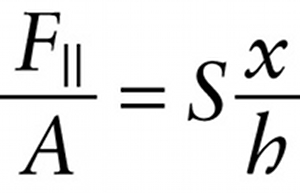Hooke's law for an object under shear stress (9-9)
Question 1 of 3
Question
Shear stress on the object: force applied to each of two opposite surfaces ivided by the area of each surface
{"title":"Shear stress on the object: force applied to each of two opposite surfaces divided by the area of each surface","description":"Correct!","type":"correct","color":"#99CCFF","code":"[{\"shape\":\"poly\",\"coords\":\"82,133\"},{\"shape\":\"rect\",\"coords\":\"2,3,96,174\"}]"} {"title":"Shear modulus: How difficult it is to deform the material of which the object is made: larger value means more difficult.","description":"Wrong","type":"incorrect","color":"#ffcc00","code":"[{\"shape\":\"rect\",\"coords\":\"118,11,119,13\"},{\"shape\":\"rect\",\"coords\":\"187,57,229,120\"},{\"shape\":\"rect\",\"coords\":\"154,37,157,37\"}]"} {"title":"Shear strain of the object: distance that the two surfaces move relative to each \perpher divided by the distance between the surfaces","description":"Incorrect","type":"incorrect","color":"#333300","code":"[{\"shape\":\"rect\",\"coords\":\"240,25,289,78\"}]"}Review
We can use the above definitions of shear stress and shear strain (shown in Figure 9-12) to rewrite Equation 9-8 as:

